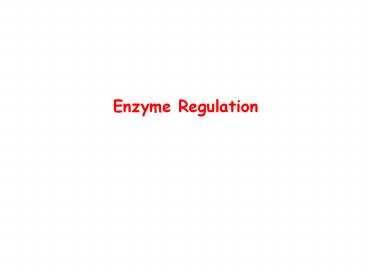Enzyme Regulation - PowerPoint PPT Presentation
Title:
Enzyme Regulation
Description:
Acetyl-CoA Carboxylase. acetyl-CoA CO2 ATP malonyl-CoA ADP Pi ... Fatty acyl-CoA. Proteolytic cleavage of proenzyme(zymogen) Proinsulin to Insulin ... – PowerPoint PPT presentation
Number of Views:121
Avg rating:3.0/5.0
Title: Enzyme Regulation
1
- Enzyme Regulation
2
Regulation of Enzyme Activity
- Enzyme quantity regulation of gene expression
(Response time minutes to hours) - Transcription
- Translation
- Enzyme turnover
- Enzyme activity (rapid response time fraction
of seconds) - Allosteric regulation
- Covalent modification
- Association-disassociation
- Proteolytic cleavage of proenzyme
3
Allosteric Regulation
- End products are often inhibitors
- Allosteric modulators bind to site other than the
active site - Allosteric enzymes usually have 4o structure
- Vo vs S plots give sigmoidal curve for at least
one substrate - Can remove allosteric site without effecting
enzymatic action
4
Regulation of Enzyme Activity(biochemical
regulation)
- 1st committed step of a biosynthetic pathway or
enzymes at pathway branch points often regulated
by feedback inhibition. - Efficient use of biosynthetic precursors and
energy
5
Phosphofructokinase( PFK)
Fructose-6-P ATP -----gt Fructose-1,6-bisphosphat
e ADP
- PFK catalyzes 1st committed step in glycolysis
(10 steps total) - (Glucose 2ADP 2 NAD 2Pi ? 2pyruvate 2ATP
2NADH) - Phosphoenolpyruvate is an allosteric inhibitor of
PFK - ADP is an allosteric activator of PFK
6
Allosteric modulators bind to site other than the
active site and allosteric enzymes have 4o
structure
Fructose-6-P ATP -----gt Fructose-1,6-bisphosphat
e ADP
ADP
Allosteric Activator (ADP) binds distal to active
site
7
Vo vs S plots give sigmoidal curve for at least
one substrate
Binding of allosteric inhibitor or activator does
not effect Vmax, but does alter Km Allosteric
enzyme do not follow M-M kinetics
8
Allosteric T to R transition
S
9
Covalent modification
- Regulation by covalent modification is slower
than allosteric regulation - Reversible
- Require one enzyme for activation and one enzyme
for inactivation - Covalent modification freezes enzyme T or R
conformation
10
Phosphorylation /dephosphorylation
- most common covalent modification
- involve protein kinases/phosphatase
- PDK inactivated by phosphorylation
- Amino acids with OH groups are targets for
phosphorylation - Phosphates are bulky (-) charged groups which
effect conformation
11
Enzyme Regulation by Association/Disassociation
- Acetyl-CoA Carboxylase
- acetyl-CoA CO2 ATP ? malonyl-CoA ADP Pi
- 1St committed step in fatty acid biosynthesis
- In presence of citrate activated
- In presence of fatty acyl-CoA inactivated
citrate
polymerized
unpolymerized
Fatty acyl-CoA
12
Proteolytic cleavage of proenzyme(zymogen)
13
Proinsulin to Insulin
14
Blood Clotting
- Clotting involves series of zymogen activations
- Seven clotting factors are serine proteases
involved in clotting cascade rxns
X
X
X
X
X
X































